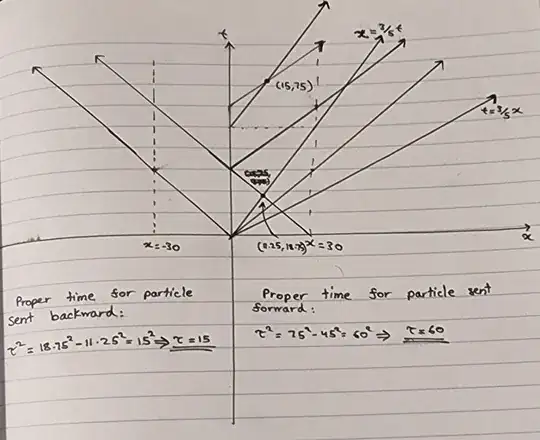Consider a closed universe that's a 1D circle with circumference of $30$ light years in an inertial reference frame that we'll call $C_1$.
This universe has an observer who is travelling at a constant speed of $3/5c$ to the right according to our first reference frame and nothing else. Since they're not accelerating they are also in an inertial reference frame which we'll call $C_2$.
To measure the circumference of the universe for themselves, they send a photon in one direction and measure the proper time they experience it takes for the photon to come back. Since the photon always travels at speed $c$ regardless of reference frame they know that if it takes $k$ years to see the photon again the universe must have circumference $k$ light years for them. We'll say the observer is at coordinate spacetime of $(x,t) = (0,0)$ according to $C_1$ when they send the particle.
I drew a spacetime diagram to calculate what this proper time should be, but I am getting different answers based on whether the observer sends the particle in the same direction that they are moving or the opposite direction.
Note that for the observer themselves they are at rest so don't have any preferred direction for sending the particle, all they see is that they send it in one direction and eventually it comes back to them from the opposite direction:
If the photon is sent in the opposite direction to the observer, then the observer first meets the particle at coordinate spacetime $(x,t) = (11.25,18.75)$ in the frame $C_1$ which we get from solving the pair of equations $x = 3/5t; x = 30-t$ (with the photon wrapping around once). This leads to a proper time observed of $\tau^2 = t^2-x^2 = 18.75^2-11.25^2 = 15^2$ so $\tau = 15$ and our observer thinks the universe has circumference $15$ light years.
If the photon is sent in the same direction as the observeris moving according to $C_1$ then the equations to solve are $x=3/5t; x=t-30$ and so the observer first meets the particle at coordinate spacetime $(x,t) = (45,75) \cong (15,75)$ where the observer makes one complete circumnavigation of the universe and the photon two of them and the proper time experienced by the observer is $\tau^2 = t^2-x^2 = 75^2-45^2 = 60^2$ so $\tau = 60$ and our observer considers the universe to have a circumference of $60$ light years.
I don't understand what makes it possible for these answers to be so different here where we have a factor of 4 difference in the universe size according to the observer based on whether they send the particle to the left or the right, what am I missing here?
Also, if I just use the standard length contraction formula (e.g. assume there is a big ruler in the universe which in $C_1$ has a length of 30 light years), then I get that in $C_2$ the circumference of the universe should be $L_0\sqrt{1-v^2/c^2} = 30 \times 4/5 = 24$ light years, which is a different answer to both the other ones...
